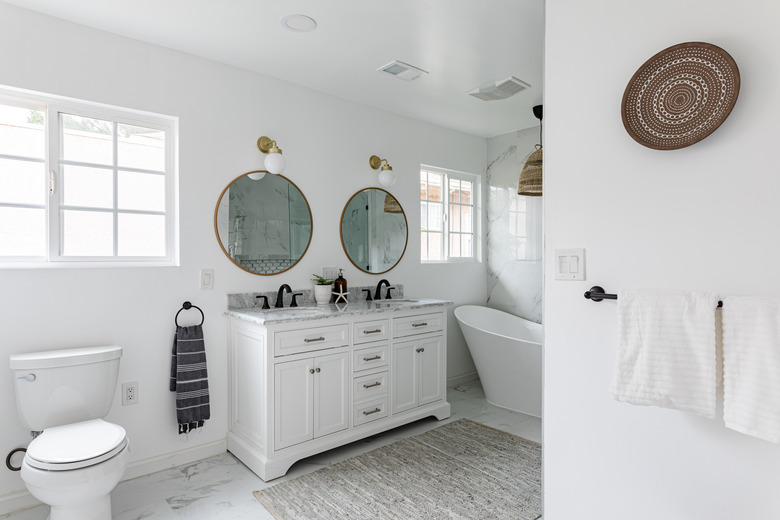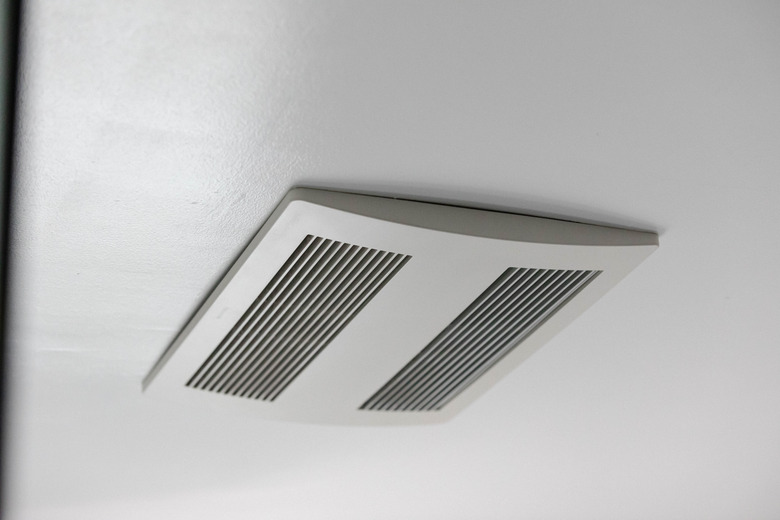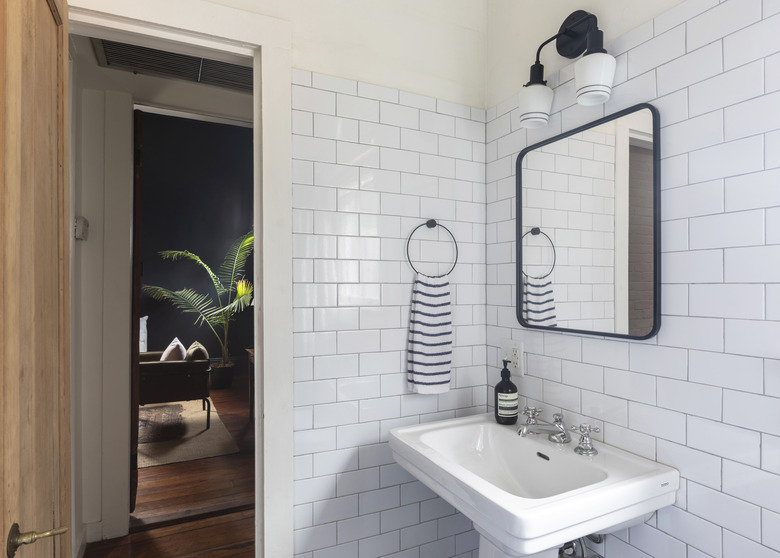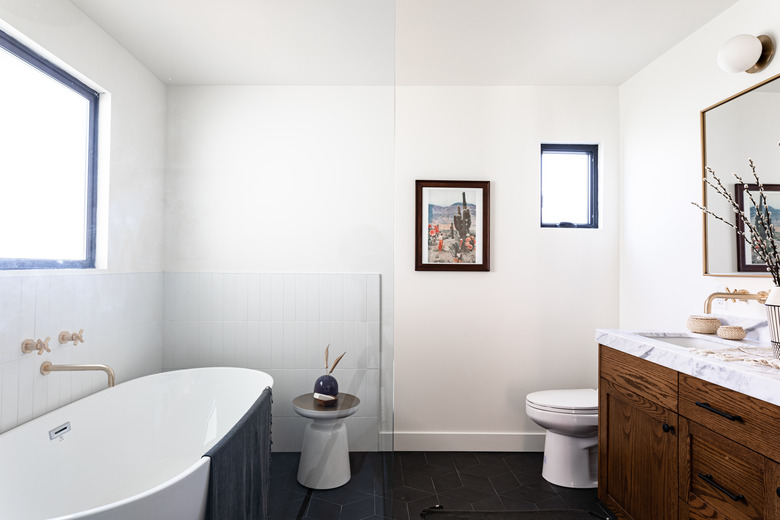Bathroom Vent Fan Guide: Choosing, Sizing And Buying Guide
We may receive a commission on purchases made from links.
While it's easy to overlook the need for a bathroom vent fan when remodeling the room, this basic feature helps keep your home environment comfortable and healthy. Besides removing odors, a bathroom exhaust fan removes excessive moisture that could otherwise lead to problematic mold and mildew. Any bathroom of any size should have a vent fan, but the best fan for the job depends on the size of the room. Some also provide added conveniences, such as timers, overhead lighting, moisture sensors and even a heat feature.
The Importance of Bathroom Ventilation Fans
The Importance of Bathroom Ventilation Fans
Proper bathroom ventilation doesn't just take the moisture out of the room; it sends that moisture outside. An improper installation may vent the fan to an attic or area above the ceiling, which could cause huge issues down the road. Mold and mildew love damp, dark environments, so a fan should never release the damp bathroom air to such an area within your home. A properly vented fan sends that air outside via ductwork that ultimately reaches your home's exterior through a wall or the roof.
Proper ventilation is also important while cleaning the bathroom with household chemicals. Many off-the-shelf products contain bleach or other strong-smelling chemicals that should only be used with proper ventilation. Turning on the bathroom vent fan while cleaning helps get rid of those odors in a hurry. Opening nearby windows is also a great idea after the fan is off, as this will bring some fresh air in too.
Sizing the Bathroom Fan to the Room
Sizing the Bathroom Fan to the Room
Not just any bathroom vent fan will suffice for every bathroom; a bit of math comes into play for choosing the best fan for the space. Fans are rated in their ability to move air, measured in cubic feet per minute (or CFM). If the fan isn't powerful enough for your bathroom, it won't sufficiently remove moisture and odors from the room. For the typical bathroom, the Home Ventilating Institute recommends choosing a fan rated at 1 CFM per square foot of bathroom space or a minimum of 50 CFM for any bathroom.
For a bathroom of greater than 100 square feet, increase the fan capacity to another 50 CFM per toilet, shower or standard bathtub. If the tub has jets, increase the fan capacity by 100 CFM instead of 50. If your large bathroom is an unusual shape, such as an "L" shape, or if it has different moisture-creating features at different parts of the room, installing two ventilation fans is also an option.
For example, a bathroom with a jetted tub in one area and a walk-in shower plus a toilet and sink in another, it makes sense to ventilate the jetted tub area with one fan and the shower, toilet and sink area with another. Ultimately, the choice is yours, but placing separate fans in areas near the moisture sources will help remove excess humidity more efficiently. You can shop for fans by size at The Home Depot.
Noise Level of a Ventilation Fan
Noise Level of a Ventilation Fan
While probably not your primary concern when choosing a bathroom exhaust fan, the noise emitted by the fan is worth a mention, as an overly noisy fan probably won't get used as often as it should, making its presence somewhat pointless. The sound emitted by a bathroom fan is measured in sones, a unit of subjective loudness based on how loud a fan seems to human ears. One sone is on par with the quiet hum of a refrigerator, and two sones is twice as loud.
As far as bathroom fans are concerned, look for a fan rated 1.5 sones or quieter if you prefer a peaceful bathroom environment, otherwise the fan may seem too loud. Some bathroom exhaust fans can be as quiet as .3 sones, while a loud fan may rate as high as 4 sones. For a remote vent fan located farther down a duct, a somewhat high sones rating may not be an issue since the fan is farther away. In these instances, however, rattling ductwork could contribute noise. The straighter and smoother the ducts run, the better in terms of both noise and the ability to draw air from the room.
Bath Fans Aren't Just for Ceilings
Bath Fans Aren't Just for Ceilings
The ceiling is a logical location for a bathroom exhaust fan in many cases since heat and steam rise, but it's not the only option. A bathroom vent fan can also be installed in a wall or as an inline or remote fan.
Wall-mounted bathroom exhaust fans are most common in a first-floor bathroom with an exterior wall, where there's no realistic way to vent a ceiling-mounted exhaust fan through the roof. As with ceiling exhaust fans, these must vent to the outdoors, as the goal is to reduce indoor moisture and odors.
A remote fan, sometimes called an inline fan, operates through a duct system that reaches multiple locations in a home. A vent opening is in the bathroom ceiling, but the actual fan unit sits somewhere else along the duct work. This option allows one inline fan to vent several bathrooms. It's also a good option for a large bathroom that requires more than one vent, such as a room with a hot tub and a shower located in opposite areas of the room.
Ventilation Fan Installation Location Matters
Ventilation Fan Installation Location Matters
Installing a vent fan directly over a tub or shower may seem like the most obvious location choice, but this also requires a fan specifically made for this purpose. A vent fan positioned above a shower, tub or hot tub requires a ground-fault circuit interrupter connection. The vent fan also must be rated for a shower or tub area. Vent fans that have a heat feature should not be placed above a shower, although those with built-in lighting can go above a shower as long as they're approved for this location.
The best location for a vent fan is directly above the tub or shower, as this area is the source of the excessive moisture. For 1/2 baths or other bathroom layouts that do not have a tub or shower, directly above the toilet area is a good location.
Energy Star Efficiency for Bath Fans
Energy Star Efficiency for Bath Fans
Look for an Energy Star rating when selecting a bathroom fan. This rating means the fan uses less energy than a similar fan without the Energy Star rating. The Energy Star rating means 70 percent less energy usage than a standard similar ventilation fan that doesn't qualify, so the savings could be significant over time.
Fans with an Energy Star rating are also noted for better blade design and motor performance, both which may indicate quality products compared to fans without this rating. For additional assurance of quality, look for fans tested and certified by the Home Ventilating Institute. These products show "HVI certified" on their packaging or product information. The better quality the fan, the longer it will likely last, saving money in the long run.
Extra Bathroom Fan Features
Extra Bathroom Fan Features
Modern bathroom exhaust fans offer more than just ventilation or a fan/light combo. Fans on a timer automatically shut off after a selected amount of time, which serves as a great alternative to forgetting the fan is on after you leave the bathroom. Special wall switches with this timer feature come in handy for bathroom vent fans that turn on via a wall switch. Some bathroom ventilation fans also have several speed settings, allowing you to tailor the speed to the most efficient option for the bathroom.
Moisture-sensing fans, such as those offered by Broan NuTone, eliminate the guesswork and only turn on when needed. This type of fan can tell when the humidity rises to a specific level, turning on and then off again once the excess moisture has been removed. This type of fan is usually meant for installation directly above a tub or shower, but always check the product information for specifics before purchase.
Some fans, such as the WhisperWarm by Panasonic, also include a built-in heat feature, adding noticeable warmth to the room within a few minutes. This comes in handy in cooler climates and for bathrooms that may not have a dedicated heat source. This particular vent fan requires its own dedicated 20-amp circuit, so be sure your home has the required circuitry before purchasing such a fan unless you don't mind the added cost of upgrading the wiring.
Vent Fan Styling
Vent Fan Styling
Most bathroom ventilation fans look incredibly similar and basic, with a nondescript white wall or ceiling plate that's obviously a vent cover. Some are round, some are rectangular and some have a built-in light that may be slightly domed. In some cases, several colors of vent covers are available, which is especially convenient for a wall-mounted fan being installed on a wall that isn't white.
Some companies have recognized the desire for designs that offer a bit of decor rather than just basic functionality. Hunter makes a full line of decorative bath fans that look more like ceiling light fixtures. These resemble fixtures that might be found in a hallway or bedroom, and the ventilation ports aren't obvious at all, even in close-up product photos. As with any ventilation fans, read the product information for installation location requirements, as some of these may not be rated for use directly above a shower or tub.
Other Bathroom Ventilation Considerations
Other Bathroom Ventilation Considerations
When choosing the best location for your bathroom vent fan, place it away from other potential air intake sources, such as a window or the bathroom door. If a bathroom window is close to the vent fan and the window is open while the fan is turned on, the fan may draw outside air up through the vent fan, which wastes energy and could make it take longer to remove all of the moisture from the bathroom.
The bathroom door should also have at least 5/8 inch of clearance beneath it when the door is closed so the fan can draw some nonhumid air into the room from afar. It also helps replace the air being drawn out of the room. Partially opening the bathroom door after a shower while the fan is still on also helps quickly remove excessive moisture.
If you live in a climate with cold winters, insulating the ductwork connected to the vent fan is also a good idea. This helps prevent condensation on or in the ductwork. Without insulation, some of that condensation could drip back into the room through the ceiling vent or drip into spaces above the ceiling, which could eventually cause problems if the moisture is excessive.
References
- Sylvane: 5 Things to Consider When Buying a Bathroom Fan
- Venmar: What is the CFM Rate and What Is a Sone?
- Home Ventilating Institute: Bathroom Exhaust Fans – A Consumer Guide
- Today's Homeowner: Tips on Where and How to Install a Bathroom Vent Fan
- Broan NuTone: Broan® ULTRA GREEN™ 110 CFM Humidity Sensing Ventilation Fan
- Panasonic: WhisperWarm, Fan|Heater, 110 CFM



